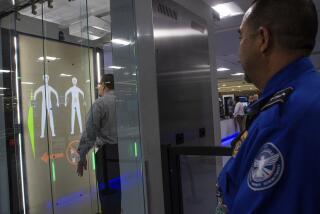Detectors Designed to Sniff Out Plastic Explosives
- Share via
There’s probably a “Snoope” in your travel future, although the majority of air passengers are not likely to ever meet this new airport personality face to face.
No, it’s not another character in the Peanuts cartoon strip, but one of the new bomb-detection units being added to airline/airport security.
Known technically as the System for Nuclear Observation of Possible Explosives, it’s referred to more commonly as TNA, for Thermal Neutron Analysis.
The FAA has, in effect, directed U.S. airlines to place these machines at 40 as-yet-unnamed airports around the world that handle American passengers.
“The specific rule is that airlines have to provide security against plastic explosives with an approved device, and the only one we’ve approved is the TNA device because we think it’s the best one,” said an FAA spokesman.
Supplying the first 40 airports is expected to take three years or less.
There has been some question about both the expense and effectiveness of the TNA unit, and a congressional hearing is set for later this month on the issue. The units cost approximately $1 million each.
E-Scan Multi-Image X-ray Scanning System, another new device developed to detect plastic explosives, has also been deployed by various airlines offering international flights, according to Ray Yates, president of the Long Beach-based Astrophysics Research Corp., the firm that markets the product.
Both of the devices are expected to help detect the kind of plastic explosives that downed the Pan Am jet over Scotland late last year.
These bombs all have a great deal of nitrogen, so TNA bathes luggage in a cloud of low-energy neutrons that pass easily through metals and other heavy materials to determine if there is nitrogen in a piece of baggage.
Suspect Luggage
If the machine detects a piece of luggage with nitrogen, a beeper and light activate and the item is dislodged from the flow of other bags, said Hadi Bozorgmanesh, vice president of San Diego-based Science Applications International Corp., the company that developed TNA. Up to this point, the machine provides security without human interpretation.
The bombardment of luggage by these neutrons is not supposed to produce any significant radioactivity, according to Bozorgmanesh, who said the safety of the technology was confirmed by the Nuclear Regulatory Commission and the California Department of Health Services.
What happens if your suitcase does produce a warning signal?
“The piece of luggage is then evaluated, in terms of its visual images, by a specially trained person,” Bozorgmanesh said. “The visual imagery produces a three-dimensional effect, so it’s difficult to hide anything.
“The person examining the luggage would need a great deal more training than the typical person handling the X-ray machine. We have a six-week training course for airlines.”
The TNA units can handle up to 600 pieces of luggage an hour, about the same as an X-ray machine.
The devices, of course, don’t have a long track record. Although considered technologically sound, there may be operational changes as they are put into practice. Critics have also questioned if the units can detect small bombs.
Flight Delays Possible
“TNA is about 95% accurate,” Bozorgmanesh said. “To bring it up to 100% would mean more false alarms, so 95% is a compromise but still a very high success ratio.”
More false alarms would mean more hand-checking of luggage and, thus, more flight delays.
TNA units were tested in San Francisco and LAX, and the first unit was put into place at TWA facilities at John F. Kennedy Airport in New York City this summer. A second is scheduled to be put into use later this year at Gatwick Airport in London.
Unlike the TNA device, the E-Scan unit requires an operator. “We consider that an advantage, as you can’t replace the human brain,” Yates said.
E-Scan uses two separate X-ray images, with organic material appearing as orange and inorganic material as blue on one screen.
The presence of dark orange suggests a possible explosive, although some benign objects might produce that effect. Accordingly, the operator then checks the shape of the suspect object before security swings into action.
TNA Rated Highest
The FAA expects to require airlines to use some such device, but has yet to specify which units will be used. So far, TNA gets the highest marks.
An amendment to the FAA’s security rules, if approved, would require all airlines, with planes that have more than 60 seats and are scheduled or chartered international flights, be responsible for security to detect these kinds of plastic explosives.
To provide consistently good security, devices would have to be installed at every major United States and foreign airport. Baggage is often moved from one plane to another on connecting flights, with luggage checked in at the initial airport. The use of such units on domestic flights might bring about earlier check-in times.
Airlines have been required by the FAA to provide security, often hiring local contract personnel to handle this function for them. If the airlines have to pay for expensive detection units, fares will robably rise to offset the cost.
Congressional legislation, which would have mandated that the federal government pay for additional units, has been defeated, Bozorgmanesh said, but the bill may be revived in a different form.
Other new detection devices, for check-through and carry-on luggage, have been deployed at some airports.
One such item is a vapor detection unit that has been tested at Boston’s Logan Airport. A passengers in a special booth is swept with a current of warm air.
Once the passenger steps out, the air is pumped into a chamber to analyze it for telltale signs of vapor pressure that indicate the presence of plastic explosives.
No matter how much technology improves airport security, the process still depends primarily on the professionalism and alertness of security personnel, which is why closer scrutiny is being kept today on who has access to airport and aircraft areas.
More to Read
Sign up for Essential California
The most important California stories and recommendations in your inbox every morning.
You may occasionally receive promotional content from the Los Angeles Times.













